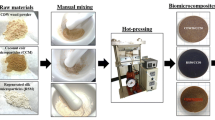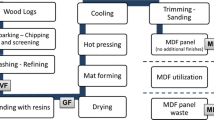Abstract
This study reports on the beneficiation of wood sawdust into cellulose nanocrystals (CNC) for application as a binder in the manufacture of particleboard. The cellulose nanocrystal from wood sawdust was extracted using acid hydrolysis and an oxidizing agent. This was used as it is for particleboard fabrication, likewise, after cross-linking with several cross-linking agents, viz., CNC-glyoxal, CNC-hexamine, CNC-polyamide–epichlorohydrin, and CNC-polyethylene to make cross-linked binders. The tensile strength performances of the particleboard panels were determined by modulus of rupture (MOR) and elasticity (MOE). The characterization of the CNC by Fourier transform infrared spectroscopy (FTIR) confirmed cellulose functional structures in the CNC. X-ray diffraction (XRD) analysis indicated high crystallinity index (78%) of the CNC and typical nano-dimensions of 2.1–10 nm for diameter and 150–350 nm for length as revealed by the transmission electron microscope (TEM). Thermogravimetric analysis (TGA) and differential thermogravimetric (DTG) analyze high thermal stability (250–400 ℃) of the CNC. Significant mechanical strength performances of the particleboard panels were evident in the modulus of rupture (MOR) and the modulus of elasticity (MOE) values that were determined. The panels met grade 1-L-1 specification of the American National Standards Institute A208.1. The incorporation of cross-linking agents enhanced the static bending and bonding strength properties of the formulated bio-binders. It can be concluded that cellulose nanocrystals extracted from waste wood sawdust could be considered for use as a binder to produce environmentally friendly wood composites bio-adhesives and particleboard panel fabrication.
Graphical abstract









Similar content being viewed by others
Data availability
The cellulose nanocrystals (CNC) generated in this work will be made available to other research groups upon request to the authors (O. D. Fagbemi, 217,080,870@stu.ukzn.ac.za, and B. Sithole, sitholeb1@ukzn.ac.za).
Code availability
Not applicable.
References
Mao A, Kim MG (2013) Low mole ratio urea–melamine–formaldehyde resins entailing increased methylene-ether group contents and their formaldehyde emission potentials of wood composite boards. BioResources 8(3):4659–4675
Vick CB (1999) Adhesive bonding of wood materials. Wood handbook: wood as an engineering material. Madison, WI: USDA Forest Service, Forest Products Laboratory, 1999. General technical report FPL; GTR-113: Pages 9.1–9.24, 113
Tesfaye T, Sithole B, Ramjugernath D (2018) Valorisation of waste chicken feathers: optimisation of decontamination and pre-treatment with bleaching agents using response surface methodology. Sustainable Chemistry and Pharmacy 8:21–37
Liu W, Ni Y, Xiao H (2004) Montmorillonite intercalated with polyaminoamide–epichlorohydrin: preparation, characterization, and sorption behavior. J Colloid Interface Sci 275(2):584–589
Zhao X (2017) Biomass-based formaldehyde-free bio-resin for wood panel process, in Handbook of Composites from Renewable Materials V.K. Thakur, M.K. Thakur, and M.R. Kessler, Editors, John Wiley & Sons: USA
Amini E et al (2017) Utilization of cellulose nanofibrils as a binder for particleboard manufacture. BioResources 12(2):4093–4110
Tayeb A et al (2018) Cellulose Nanomaterials—binding properties and applications: a review. Molecules 23(10):2684
Adhikari BB et al (2018) Development of hydrolysed protein-based plywood adhesive from slaughterhouse waste: effect of chemical modification of hydrolysed protein on moisture resistance of formulated adhesives. RSC Adv 8(6):2996–3008
Adhikari BB, et al. (2017) Protein-based wood adhesives current trends of preparation and application, Z. He, Editor, Taylor & Francis Group, LLC USA
Obokata T, Yanagisawa M, Isogai A (2005) Characterization of polyamideamine-epichlorohydrin (PAE) resin: roles of azetidinium groups and molecular mass of PAE in wet strength development of paper prepared with PAE. J Appl Polym Sci 97(6):2249–2255
Wågberg L, Bjőrklund M (1993) On the mechanism behind wet strength development in papers containing wet strength resins. Nord Pulp Pap Res J 8(1):53–58
Espy HH (1995) The mechanism of wet-strength development in paper: a review. Tappi journal (USA)
Alawode AO et al (2020) Performance evaluation of a natural based adhesive derived from Irvingia wood species kernel extracts on wood panel production. J Adhes Sci Technol 34(9):995–1012
Solt P et al (2019) Technological performance of formaldehyde-free adhesive alternatives for particleboard industry. Int J Adhes Adhes 94:99–131
He Z (2017) Bio-based wood adhesives: preparation, characterization, and testing. 2017: CRC Press
Wohlhauser S et al (2018) Grafting polymers from cellulose nanocrystals: synthesis, properties, and applications. Macromolecules 51(16):6157–6189
Rowell RM, et al. (2005) Cell wall chemistry. Handbook of wood chemistry and wood composites, 2005. 2.
Olufemi B, Akindeni JO, Olaniran SO (2012) Lumber recovery efficiency among selected sawmills in Akure Nigeria. Drvna industrija 63(1):15–18
Müller C, et al. (2007) Natural binders, in Wood production, wood technology, and biotechnological impacts U. Kües, Editor. Universitätsverlag Göttingen Germany
Klemm D, et al. (1998) Comprehensive cellulose chemistry: fundamentals and analytical methods. Vol. Volume l. Germany: WILEY-VCH Verlag GmbH
Gibril M et al (2018) Optimisation and enhancement of crystalline nanocellulose production by ultrasonic pretreatment of dissolving wood pulp fibres. Cellul Chem Technol 52:9–10
Tang J et al (2017) Functionalization of cellulose nanocrystals for advanced applications. J Colloid Interface Sci 494:397–409
George J, Sabapathi S (2015) Cellulose nanocrystals: synthesis, functional properties, and applications. Nanotechnol Sci Appl 8:45
Tajvidi M, Gardner DJ, Bousfield DW (2016) Cellulose nanomaterials as binders: laminate and particulate systems. Journal of Renewable Materials 4(5):365–376
Veigel S et al (2012) Particle board and oriented strand board prepared with nanocellulose-reinforced adhesive. J Nanomater 2012:15
Kojima Y et al (2013) Binding effect of cellulose nanofibers in wood flour board 59(5):396–401
ASTM (2013) Standard test methods for evaluating properties of wood-base fiber and particle, in ASTM D1037–13. 2013, American Society for Testing and Materials: West Conshohocken: Annual Book of ASTM Standards; 2013
Shaheen TI, Emam HE (2018) Sono-chemical synthesis of cellulose nanocrystals from wood sawdust using acid hydrolysis. Int J Biol Macromol 107:1599–1606
Mahmud MM et al (2019) Preparation of different polymorphs of cellulose from different acid hydrolysis medium. Int J Biol Macromol 130:969–976
Landry V, Alemdar A, Blanchet P (2011) Nanocrystalline cellulose: morphological, physical, and mechanical properties. For Prod J 61(2):104–112
Li W, Wang R, Liu S (2011) Nanocrystalline cellulose prepared from softwood kraft pulp via ultrasonic-assisted acid hydrolysis. BioResources 6(4):4271–4281
Kargarzadeh H et al (2012) Effects of hydrolysis conditions on the morphology, crystallinity, and thermal stability of cellulose nanocrystals extracted from kenaf bast fibers. Cellulose 19(3):855–866
Gong J et al (2017) Research on cellulose nanocrystals produced from cellulose sources with various polymorphs. RSC Adv 7(53):33486–33493
Qin Y et al (2017) Synergistic effect of glycerol and ionic strength on the rheological behavior of cellulose nanocrystals suspension system. Int J Biol Macromol 102:1073–1082
Bondeson D, Mathew A, Oksman K (2006) Optimization of the isolation of nanocrystals from microcrystalline cellulose by acid hydrolysis. Cellulose 13(2):171
Roman M, Winter WT (2004) Effect of sulfate groups from sulfuric acid hydrolysis on the thermal degradation behavior of bacterial cellulose. Biomacromol 5(5):1671–1677
Chieng BW et al (2017) Isolation and characterization of cellulose nanocrystals from oil palm mesocarp fiber. Polymers 9(8):355
Wang HY, Huang MF (2007) Preparation, characterization and performances of biodegradable thermoplastic starch. Polym Adv Technol 18(11):910–915
Kelly MW (1977) Critical literature review of relationships between processing parameters and physical properties of particleboard. Vol. 10. : US Department of Agriculture, Forest Service, Forest Products Laboratory
ANSI, Particleboard (2016) Gaithersburg (MD): Composite Panel Association 2016, in ANSI A208.1–16. 2016, American National Standards Institute
Mekonnen TH et al (2014) Adhesives from waste protein biomass for oriented strand board composites: development and performance. Macromol Mater Eng 299(8):1003–1012
Carll C (1986) Wood particleboard and flakeboard: types, grades, and uses. Vol. 53 : US Department of Agriculture, Forest Service, Forest Products Laboratory
Gui C et al (2013) Preparation of a new type of polyamidoamine and its application for soy flour-based adhesives. J Am Oil Chem Soc 90(2):265–272
Acknowledgements
The authors acknowledge the funding and the support received from the Bio-refinery Industry Development Facility (BIDF) from the Council for Scientific and Industrial Research (CSIR) and the Department of Science and Innovation (DSI), South Africa. Dr. Viren and Dr. Prabashini are highly appreciated and the technical support of Mr. Navan. The authors acknowledged the help of Dr. Luvuyo Tyoda and Dr. Abiodun Alawode of the Department of Forestry and Wood Science at Stellenbosch University, South Africa, during the production and testing of the particleboard panels.
Funding
Council for Scientific and Industrial Research (CSIR), the Bio-refinery Industry Development Facility (BIDF), and the Department of Science and Technology (DST) South Africa, Waste Research Development and Innovation Roadmap, and the Bio-refinery Consortium research project.
Author information
Authors and Affiliations
Contributions
Fagbemi Olajumoke: investigation, methodology, data curation, writing—original draft preparation, formal analysis, validation, and visualization.
Bruce Sithole: resources, supervision, funding acquisition, conceptualization, and writing—review and editing.
Jerome Andrew: supervision and writing—review and editing.
Corresponding author
Ethics declarations
Ethics approval
Not applicable.
Human and animal rights participants
Not applicable.
Consent to participate
Not applicable.
Conflict of interest
The authors declare no competing interests.
Additional information
Publisher's note
Springer Nature remains neutral with regard to jurisdictional claims in published maps and institutional affiliations.
Rights and permissions
About this article
Cite this article
Fagbemi, O.D., Andrew, J.E. & Sithole, B. Beneficiation of wood sawdust into cellulose nanocrystals for application as a bio-binder in the manufacture of particleboard. Biomass Conv. Bioref. 13, 11645–11656 (2023). https://doi.org/10.1007/s13399-021-02015-6
Received:
Revised:
Accepted:
Published:
Issue Date:
DOI: https://doi.org/10.1007/s13399-021-02015-6




